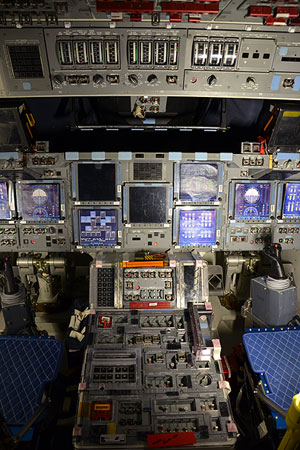 advertisements advertisements
|

|
Photo Gallery: Touring Smithsonian-bound space shuttle Discovery
June 26, 2011 — Since wrapping up its final space flight in March, space shuttle Discovery has been undergoing preparations at Kennedy Space Center in Florida to be shipped to the Smithsonian for public display at the National Air and Space Museum's Steven F. Udvar-Hazy Center in Chantilly, Virginia.
NASA's oldest shuttle among the remaining fleet of three, Discovery is leading its sister ships Endeavour and Atlantis through a "transition and retirement" process designed to ensure the orbiters are safe to be exhibited. NASA's technicians are removing parts from Discovery that were exposed to hazardous materials, as well as taking the opportunity to save and study components that could be of value to future crewed spacecraft.
According to Stephanie Stilson, who oversaw Discovery's processing when it was still flying and now leads NASA's orbiter retirement program, steady progress has been made readying Discovery for its delivery as a museum display in 2012.
"We'll be finished with all the processing of Discovery in early February. However, that's not a very good time to ferry from Florida to DC, so we're going to move the actual ferry date to the April timeframe," Stilson told collectSPACE.
NASA will transport Discovery on the back of a modified Boeing 747 jetliner to the Udvar-Hazy Center, which has its own taxiway at Dulles International Airport, just outside Washington, DC.
"We're going to target April 12," said Stilson, noting the date as the anniversary of the first space shuttle launch in 1981 and, three decades later, the day that NASA announced Discovery would be heading to the Smithsonian.
On Tuesday (June 21), NASA provided collectSPACE a chance to tour Discovery and climb inside its crew cabin, which has been partially taken apart for servicing but will be reassembled for the Smithsonian.
"They want it to look as though the astronauts just stepped off," said Stilson. |
|

Photos: collectSPACE.com / Robert Z. Pearlman |

Above: Inside Kennedy Space Center's Orbiter Processing Facility-2 (OPF-2), space shuttle Discovery is mostly hidden behind access platforms and support hardware. Here, Discovery's name can be seen peaking out below and behind its crew cabin's forward windows. |


Above: As part of NASA's standard post-flight shuttle processing and also as part of the effort to make Discovery safe for public display, technicians removed the shuttle's forward reaction control system (FRCS), the thruster jets that helped steer the shuttle while it was in orbit. To maneuver, the FRCS utilized hypergolic fuel and oxidizer, which were purged from Discovery after its final spaceflight, STS-133.
The FRCS, which sat in the now open cavity between Discovery's nose and its crew cabin, was shipped to a maintenance facility at White Sands Space Harbor in New Mexico, where additional inspections will be performed and its components made safe to go on display. |


Above: Discovery's crew cabin's forward facing and overhead windows are covered while technicians work to prepare the shuttle. |



Above: Avionics and other flight system control boxes are exposed on Discovery's crew cabin middeck. This equipment is out of sight when the shuttle is in space, covered by a row of lockers that hold the astronauts' clothing, food, and supplies. The middeck lockers will reinstalled before Discovery goes on display. |
 
Above, right: Behind this door lies the shuttle's toilet, or at least it used to be there. The waste containment system, or WCS — NASA's term for the toilet — has been removed for servicing and sterilization, but will be in place when Discovery is on exhibit. |

Above: Looking out on the middeck at the payload bay through Discovery's open airlock and integrated space station docking adapter. |

Above: The commander's seat and controls on Discovery's flight deck. The screen covers that have been placed over the glass cockpit display reflect the type of data that each screen would provide when powered on. |

Above: Pilot's seat and controls on Discovery's flight deck. Each seat has manual flight controls, including rotation and translation hand controllers, rudder pedals and speed-brake controllers. |




Above: There are more than 2,020 separate displays and controls located on the flight deck. |

Above: The on-orbit displays and controls are at the aft end of the flight deck/crew compartment. The displays and controls on the left are for operating the orbiter, and those on the right are for operating and handling the payloads. |

Above: The view into Discovery's payload bay looking through an aft flight deck window. Six pressure windshields, two overhead windows and two rear-viewing payload bay windows are located in the upper flight deck of the crew module. |

Above: The 60-foot payload bay, where most of the shuttle's cargo is stored for launch, on-orbit operations and landing, forms the orbiter's midfuselage. |

Above: In the foreground, is the Canadian-built orbiter boom sensor system, a 50-foot, camera- and instrumentation-tipped extension for the shuttle's robotic arm. The arm itself, also known as the Canadarm, has been removed from Discovery for servicing but will be returned for the shuttle's display by the Smithsonian. |
 


Above: Discovery's underbelly (with deployed landing gear) is covered with more than 20,000 thermal protection system tiles that shielded the orbiter from the heat generated during reentry into the Earth's atmosphere. It is estimated that about 70 percent of the silica tiles flew with Discovery on all 39 of its spaceflights. |


Above: This view of Discovery's aft section shows the three openings where the space shuttle main engines had been installed. NASA is retaining all of its main engines for possible future use. Instead, Discovery (and the other orbiters) will be outfitted with replicas built from spare parts from earlier versions of the engines. |

Above: Though Discovery won't be exhibited with its original main engines, the Smithsonian has requested that NASA preserve a much of its original internal components as is safe for public display and possible. |
|

© collectSPACE. All rights reserved.
|
|
